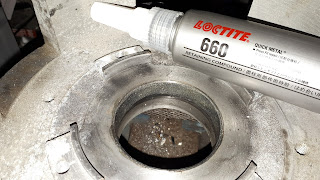I had to build a new flange to mount the K9HV into the gearbox. The flange should be at least 30mm thick to prevent the motor axle from touching the gearbox axle. I had some 8mm thick aluminium scrap sheets available for the job, so I decided to attach two such sheets together forming a 16mm thick sheet. The flange would be constructed from two plates, one 16mm plate would be mounted to the motor and an other 16mm plate into the gearbox allowing me to adjust their alignment. I started by making a model from cardboard for the gearbox plate.
Using the cardboard models I cut the gearbox plate using a jigsaw.
Locating the holes to drill was a challenge. I decided to try pressing the plate against the gearbox with some Blu-Tack in between so the hole locations would get visible. This actually worked out well. I started by making two alignment pins that the original motor had as well. After the locating pins were made it was simple to locate one hole at the time to be drilled.
Once all holes were drilled, the gearbox plate could be mounted into its final location. Now the challenge was to get the gearbox axle aligned with the motor. I decided to build a special divider tool that allowed me to draw an accurate circle matching the K9HV motor's diarmeter. This would help me to make a first rough alignment.
Next I decided to build the motor's plate. I used countersunk bolts to mount the plate on motor allowing the motor plate to be pressed directly on the gearbox plate.
The motor plate was built with the same width as the motor's diameter so I was able to locate the motor plate mounting holes quite accurately on the gearbox plate using the circle drawn earlier with the divider. I made the motor plate's holes 2mm bigger than its bolts allowing me to fine tune the alignment of the motor and gearbox axles. The fine tuning would be completed by adjusting three stop screws forcing the location of the motor plate from its bottom, left and right sides.
The motor plate's mounting bolts threads were reinforced using helicoils. These four bolts will need to carry the motor and its torque so I did not trust bare aluminium threads.
Now I had all the components ready for finishing the assembly!
First the motor plate was mounted into the motor securely using plenty of thread lock.
Then the gearbox plate was mounted roughly on its place to be aligned later.
Next I assembled the flywheel and clutch. I used a torque wrench and thread lock in all places applicable.
Finally I got to fit the motor in its place and bolt the gearbox plate securely. Then it was time to adjust the motor and gearbox axle's alignment. I had no idea how I could confirm a good enough alignment so there was a lot of trial and erroring to do. Pretty soon I noticed that when I rotated the motor by hand I could hear a quiet creak as the clutch disk was forced to move due to misalignment of the two axle's. I then adjusted the motor plates location in respect to the gearbox plate until there was no creaking sound at all. I figured this alignment is as good as I would get and lock screwed the plates together so they would not move anymore.
To make sure the motor was properly mounted, I connected the motor into its controller and gave it a spin. I was really happy with the result, there is clearly less alignment and balancing error than I had with the former ME1003 motor's mount:) This motor will drive the Corolla smoothly!
Placed the original shields on the motor and now it's ready to be lifted in the car:)






























